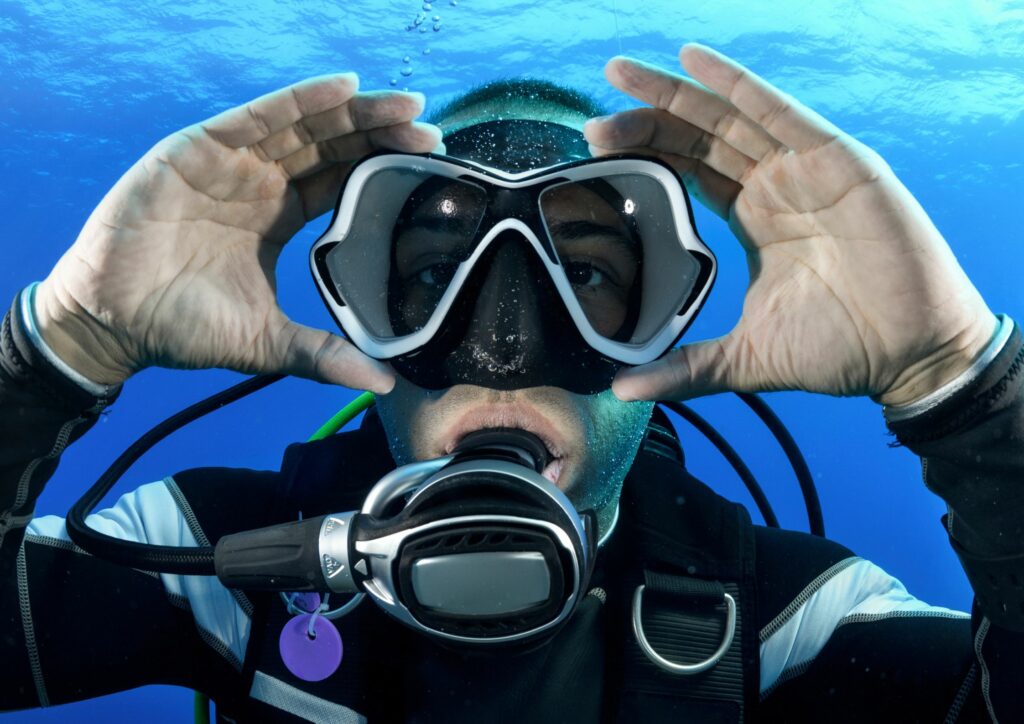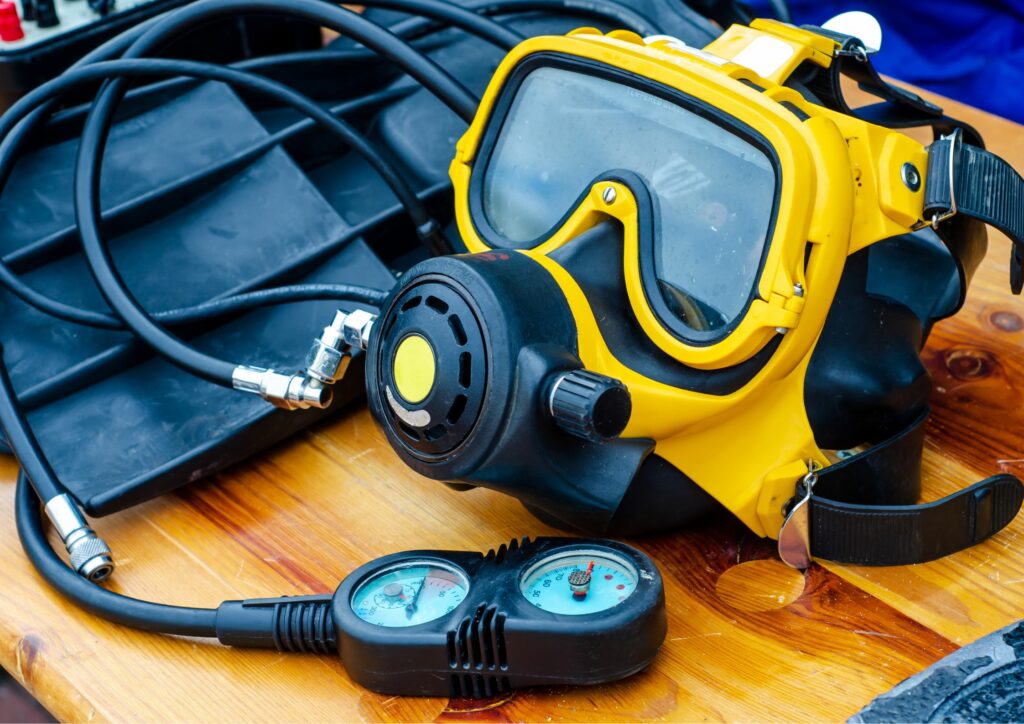Navigating the aquatic depths isn’t a dive into the unknown when equipped with the right gear. At the top of your diving equipment list, no doubt, is a quality diving mask. Ensuring your mask fits perfectly, offers optimal visibility, and caters to your personal preferences could mean the difference between a smooth underwater expedition and an experience marred by discomfort and limited vision. This article will delve into the salient aspects you should consider for diving mask such as the fit, lens type, full face mask suitability, skirt seals, visibility, volume, and the frame vs frameless conundrum.
Meticulously Evaluate the Mask Fit
Diving is an exciting adventure that opens up a whole new world beneath the water surface. Comfort and proper fit of the diving mask are paramount in this endeavour. A well-fitted diving mask can intensify this underwater experience by providing a clear and unobstructed view of the mesmerizing marine life. An ill-fitted mask, conversely, can cause discomfort due to pressure on the face, distraction because of the need for constant adjustments, and an overall undesirable diving experience due to water seepage.
Therefore, you need to meticulously evaluate the fit of the mask before your dive. Pay close attention to how the diving mask adheres to your face contours and ensure it doesn’t create undue pressure on your skin throughout the dive. Don’t compromise on your underwater journey – ensure your diving mask assures comfort, safety and the best possible view.
Luminously Illuminate with the Perfect Lens

The choice of lens for your mask can profoundly impact your underwater exploration. A tinted lens, on the other hand, enhances contrast and reduces glare from the sun. A clear lens provides the capability to perceive the smallest details and the most vibrant colours. Coupled with the right lighting, lenses significantly magnify your ability to explore the fascinating underwater world. The vividness of your experience relies heavily upon the judicious selection of the lens type for your mask. Whether you’re an avid underwater photographer capturing marine life details or a thrill-seeker who loves exploring sunny coral reefs, your choice of lens can make or break your dive experience.
The Full Face Mask – Ingenious Innovation or Impediment
Full face masks are a marvel of modern diving equipment. They provide a panoramic, unobstructed view of the underwater world and combine the breathing apparatus into a single unit for simplicity and comfort. Ideal for diving in cold or polluted water, these masks offer enhanced visibility and convenience. Yet, they are not without their drawbacks. Their size makes them a bit challenging to clear, and they can cause some drag while swimming. Aspects such as personal comfort, ease of handling and intended use should guide your choice of mask – whether it’s a traditional mask-and-snorkel setup or a full-face mask.
Secure Your Shield with Skirt Seals
The skirt seal on a diving mask is a critical component – it is the barrier between the aquatic environment and the diver’s face. Its function is to provide a watertight seal that prevents water from flooding the mask and compromising the diver’s visibility. The quality of the seal is crucial to ensure uninterrupted vision. Skirt seals are typically constructed from silicone or rubber. Silicone seals are durable, can adapt better to the contours of your face and usually offer a superior seal. Rubber, on the other hand, is less expensive but may degrade faster over time with exposure to the elements.
Volume and Visibility – A Balancing Act
The underwater experience is as much about being able to see a wide area of the underwater environment as it is about being comfortable while diving. In terms of diving masks, there is always a trade-off between volume and visibility. Low-volume masks sit closer to the face, restricting peripheral vision but provide an unobstructed direct view and are lightweight and compact. High-volume masks, on the other hand, allow for a panoramic view of your surroundings but come at the cost of being bulkier. The choice of mask volume would essentially depend on the diver’s comfort and desired visibility underwater.
Framed vs Frameless Debate: A Personal Preference
The choice between a framed and frameless diving mask primarily comes down to the diver’s personal preference. Framed masks have a solid structure, allowing for the use of multiple lens types. They are sturdy and can withstand harsh conditions. They are, however, relatively larger and bulkier. In contrast, frameless masks, being more streamlined and lightweight, offer a higher level of comfort and freedom but may fall short on customization and lens options. The structure, size, comfort, and personal fit are considerations that a diver needs to balance when choosing between a framed and frameless mask.
Masked Marvels: Unveiling Your Underwater Ally in Bali Diving
For Bali Diving, your mask becomes more than just gear—it’s your window to an underwater paradise. The right dive mask can make all the difference, offering clarity and comfort as you explore Bali’s vibrant coral reefs and diverse marine life. A well-fitted mask not only prevents leaks but also ensures a crystal-clear view, allowing you to fully immerse yourself in the underwater world. Whether you’re navigating the wrecks of Tulamben or swimming alongside manta rays in Nusa Penida, your mask is your trusty ally, unveiling the wonders that lie beneath Bali’s waves. Embrace the masked marvels of Bali diving, and let every dive be a breathtaking adventure.

I’m impressed by how detailed and informative this article is! As a diver myself, I can attest to the importance of having the right gear, especially when it comes to masks. The points raised about fit, lens type, skirt seals, and frame vs frameless are all crucial considerations for any serious diver.
Dear Aisha Tan, thank you for your kind words about our article! We’re thrilled to hear that it was informative and helpful. At Gill Divers, we believe that having the right gear is crucial for a safe and enjoyable diving experience. Our team of experts is always happy to help with any questions or concerns you may have. If you have any specific queries regarding mask selection or any other diving-related topics, please don’t hesitate to contact us at +65 6734 9373 or [email protected]. We’re here to assist you in making the most of your underwater adventures!
This article is a must-read for anyone planning to take up diving! The section on skirt seals was particularly enlightening – I never knew that silicone seals were more durable than rubber ones. Can’t wait to try out some of these tips and tricks in my next dive.
Hi Rizal Lee, thanks for sharing your thoughts on our diving mask article! We’re thrilled to hear that you found the section on skirt seals enlightening. Silicone seals do indeed offer better durability and adaptability compared to rubber ones. As you prepare for your next dive, we encourage you to explore more of our resources and tips on diving gear and techniques. If you have any questions or concerns, feel free to reach out to us at Tel: +65 6734 9373 or Email: [email protected]. We’re always here to help. Happy diving!
As someone who’s new to diving, I found this article to be super helpful. The sections on volume and visibility were really eye-opening – I had no idea that there was such a trade-off between the two! Definitely going to keep these tips in mind for my next dive.
Hi Fatima, congratulations on taking the plunge into diving! We’re thrilled to hear that our article was helpful in your journey. The trade-off between volume and visibility is indeed an important consideration when choosing a diving mask. As you continue to explore the world beneath the waves, remember to prioritize comfort and clarity. If you have any more questions or need further guidance, feel free to reach out to us at Gill Divers. We’re always here to help. Tel: +65 6734 9373, Email: [email protected]